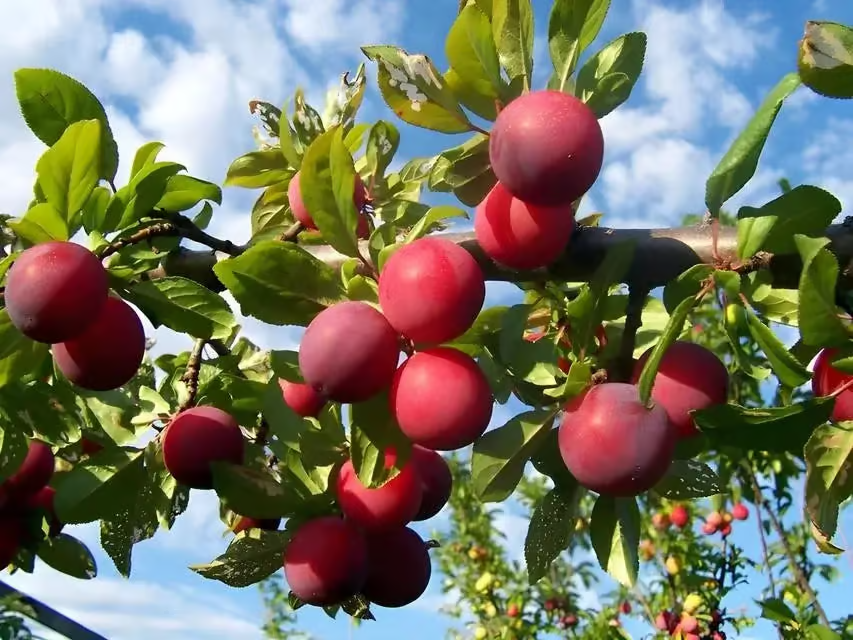
Perennials
Attracts beneficial pollinators
Increases property value significantly
Enhances garden's aesthetic appeal
Thrives in
ZONE 4ZONE 5ZONE 6ZONE 7ZONE 8ZONE 9Planting Season:
Nov-AprilPlum fruit trees produce smooth-skinned, juicy produce with various colors, including red, purple, and yellow, typically surrounded by oval-shaped leaves. They are versatile and attractive types with numerous benefits when incorporated into landscaping designs. With its ornamental features and adaptability, it can enhance the visual appeal of outdoor spaces. Plum Fruit Trees come from one also known as Prunus domestica, and they will give you plenty of them after the first three to six years. When one of these deciduous plants is first planted, they'll appear shrub-like. However, it's important to note that most varieties are trees.

Bloom Season
Spring
Bloom/Foliage Color
Pink
Height at Maturity
Under 25 Feet
Care
Plum trees thrive in well-draining soil and require regular watering, especially during dry periods. They should be pruned yearly to maintain shape and clear dead or diseased branches. In early spring, they should be fertilized to encourage healthy growth and fruit production.
Plant Reproduction
Plum fruit trees spread through seeds, grafting, and root suckers.
Plant fruit trees in early spring or late fall when the weather is cool. Choose a sunny location with well-drained soil. Dig a hole twice the width of the roots and double as deep as the root system. When the tree is put in the hole, make sure the graft union (a noticeable bump where the tree was grafted above the rootstock) is above the soil line. Put dug-out soil around the tree roots, gently firmly remove air pockets, and water thoroughly.
Water young trees regularly, especially during dry spells, to establish a robust root system. Once established, water deeply and less frequently. Prune fruit trees yearly during the dormant season to remove dead or diseased wood, improve air circulation, and shape the tree for optimal fruit production. Fertilize in early spring and thin the fruit when necessary to prevent overbearing, which can stress the tree and reduce fruit quality.
Shipping date depends on the date displayed and chosen when you order from the product's page.
We only accept returns on plants verified dead. If you think your plants have died, we offer a 1 year warranty, please use use this File a Claim Link to verify dead plants and start with return warranty process.




Delicious Fruit:
Enjoy homegrown plums that are juicy, sweet, and perfect for eating fresh or making preserves.
Self-Pollinating:
Many plum varieties are self-pollinating, which means you don’t need multiple trees to produce a bountiful harvest.
Compact Size:
Ideal for smaller gardens, this tree can fit into various garden spaces while still producing ample fruit.
Attractive Foliage:
The Plum Fruit Tree features lovely blossoms in spring and vibrant leaves in autumn, adding beauty to your garden year-round.
Caring Tips
Each box contains detailed care instructions and information about your product. But here's the basics.
Care Tips
Plum trees thrive in well-draining soil and require regular watering, especially during dry periods. They should be pruned yearly to maintain shape and clear dead or diseased branches. In early spring, they should be fertilized to encourage healthy growth and fruit production.
Light Requirements
Plum fruit trees thrive in full sun, needing 7 to 10 hours of sunlight daily. Adequate light is essential for fruit development, ensuring a healthy yield and preventing diseases. Partial shade can reduce fruit production and quality.
Hardy Planting Zones
4 • 5 • 6 • 7 • 8 • 9
How often should I water my plants?
How do I know if my plant is getting too much or too little sunlight?
What should I do to prepare my plants for winter?
What are the signs that my plant needs fertilizing?
How can I prevent pests from damaging my plants?
How do I choose the right plant for my climate zone?